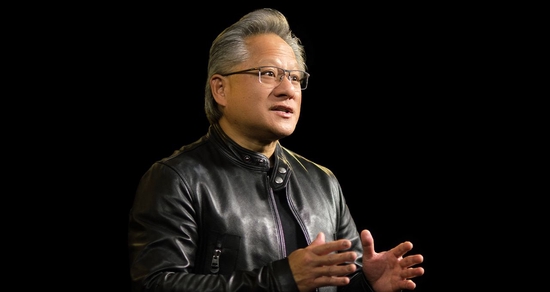your current location is:Home > TechnologyHomeTechnology
Nvidia CEO Huang Renxun: The new generation of data center GPUs are fully put into production and will provide alternative versions to the Chinese market
"This is the busiest day for GTC in recent years, and we have released a lot of things." On the evening of September 20, U.S. time, after the NVIDIA GTC conference, NVIDIA CEO Huang Renxun sat in front of the computer wearing an iconic leather jacket and told Jiemian News and other media in the Asia-Pacific region said.
Recently, NVIDIA, which ranks among the most valuable semiconductor companies in the United States with GPUs (graphics processing units), has frequently become the focus of the market and was once proud. However, as the semiconductor market enters a downward cycle, NVIDIA has also ushered in "headwinds" such as reduced demand and geopolitical disputes. A sharp pullback. In this regard, the company still maintains the established product release rhythm and has launched a number of important new software and hardware products.
In the face of global inflation, the series of chips released by NVIDIA are mainly high-end products, including the Ada Lovelace architecture RTX 40 series gaming GPU, the autonomous driving chip "Thor", etc., and announced that the high-performance data center GPU H100 has been fully put into production . Saving money and improving performance are the two major characteristics of NVIDIA's new products in Huang Renxun's mouth, and he uses "the delivered values of us off the charts" to describe the value of the delivered products.
But for consumers, the new generation of high-end gaming graphics cards is significantly more expensive than previous versions. Among them, the price of RTX 4090 is 7% higher than that of the previous generation 3090 graphics card released in 2020, and the price of 4080 is 29% higher than that of the previous generation 3080 graphics card released in 2020. The Ada Lovelace of the RTX 40 series mainly succeeds the Ampere architecture that came out in May 2020, while the RTX 30 series gaming graphics cards based on the Ampere architecture will be available in September 2020.
Huang Renxun said that the cost of semiconductors is much higher than in the past, and people must realize that Moore's Law (the number of components that can be accommodated on an integrated circuit will double every 18-24 months, and the performance will also double the semiconductor industry law. ) is over, the idea that technological advancements are driving lower and lower chip costs is no longer taken for granted, which is where Nvidia’s value in overcoming inflation with technologies such as ray tracing, tensor cores, and more. "The new product offers many times the performance of the previous generation, which was not possible in the past," he said.

"Full stack" is a technical term that Huang Renxun mentioned many times in interviews. He emphasized that Nvidia is not only a chip company, but also provides necessary software such as development toolkits and algorithms to help developers develop AI, scientific computing, Game applications, reduce the difficulty of development. He took games as an example. Even if the CPU performance of the computer becomes the bottleneck, the GPU can still double the performance of the game screen.
It is worth noting that the RTX 40 series GPU released this time switched the chip foundry, using TSMC's 4nm process technology optimized for GPUs, while the previous generation RTX 30 series was produced by Samsung.
When a South Korean reporter asked about the relationship between NVIDIA and Samsung, Huang Renxun said that the two parties involved supply chain and foundry. On the one hand, NVIDIA is currently the world's largest customer of high-bandwidth memory (HBM), and Samsung Electronics provides HBM to NVIDIA; In terms of foundry, Samsung's wafer foundry continues to produce chips such as GPUs and robot processors to Nvidia.
Huang Renxun said frankly that the outside world needs to realize that the supply chain is a very complex matter, such as mobile phones, computers, automobiles, etc. are already a global division of labor, "the most advanced organic substrates (organic substrates) come from Japan, assembled in China, wafers. Manufacturing in Taiwan, software in the U.S., from the beginning to the end, the whole world is highly integrated.” He believes that it is a good thing to consider security risks now, but looking at the supply chain does not start from a single component, but requires a holistic perspective.
This time, NVIDIA's high-performance data GPU H100 has also been put into full production, but it has not been officially shipped and has been included in the scope of export control by the US government and cannot be supplied to Chinese customers. The ban stems from an export policy launched by the U.S. government in August against China and Russia, involving two chips sold by Nvidia, the Ampere architecture A100 and this Hopper architecture H100.
In response, Huang Renxun responded that the vast majority of products currently used in the market will not be affected, and products with special applications need to apply for export certification. Nvidia will provide Chinese customers with an alternative version based on the Hopper architecture that is not restricted by the US government, which is enough to meet the vast majority of the needs of the Chinese market. For customers with a clear need for restricted products, Nvidia will try to license them.
He emphasized that NVIDIA's various products are sufficient to meet the needs of most users, and the A100 is only one of NVIDIA's five products based on the Ampere architecture, and users can also replace it with other options. "We're going to have a ton of products that are architecturally compatible and don't require a license at all."
In addition to announcing the full production of the RTX40 series GPU and H100, the Thor automotive super chip announced by NVIDIA has also attracted market attention. According to Nvidia, the chip can provide 2,000 teraflops of performance and is expected to be mass-produced in 2024 and used in models in 2025. Nvidia's Orin product, currently used in mass-produced cars, provides 254 teraflops of performance. Last year, it released Atlan, which is expected to be mass-produced in 2024 and can provide 1,000 teraflops of performance per second, and has now been replaced by Thor.
Regarding the recent hot RISC-V architecture in the semiconductor field, Huang Renxun said that Nvidia is one of the first companies in the world to use the RISC-V architecture in products, but at present, RISC-V is compared with the x86 and Arm architectures that have a complete ecological chain. Some third-party software is not ready yet. Huang Renxun believes that RISC-V is more suitable for customized products, and in the long run, it is still necessary to establish a software ecological chain, "Can RISC-V build an ecosystem similar to Arm or x86? Of course, but it may take ten years or even Twenty years."
related articles
Article Comments (0)
- This article has not received comments yet, hurry up and grab the first frame~












